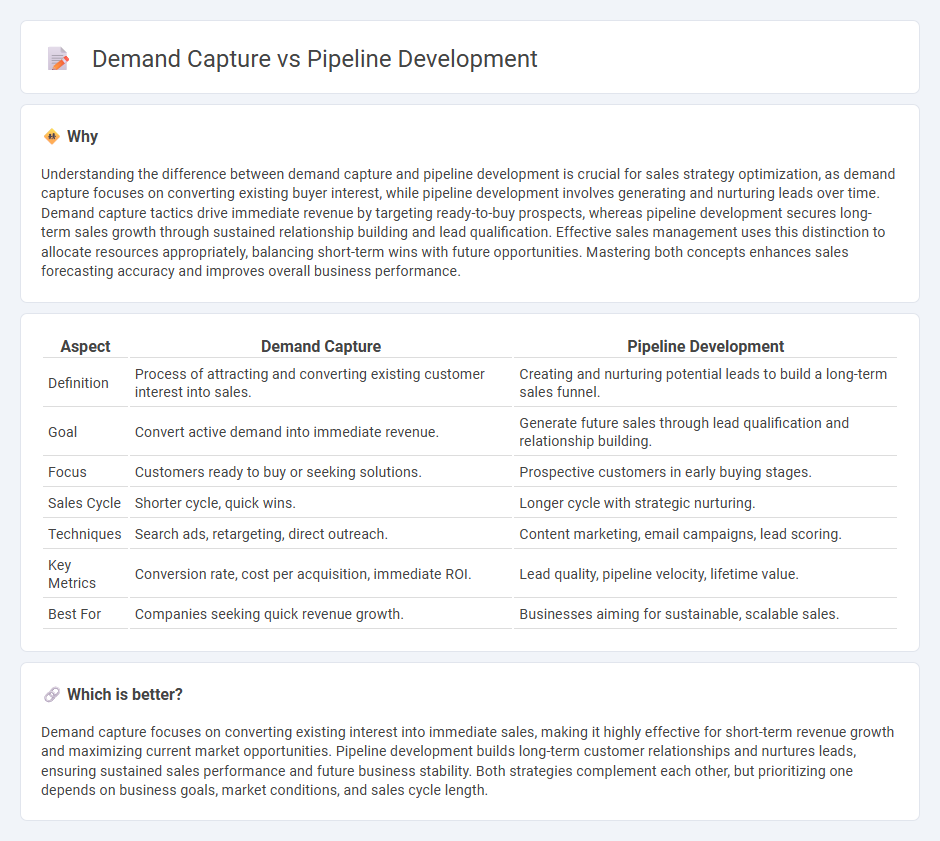
Demand capture focuses on converting existing market interest into immediate sales by targeting prospects actively seeking solutions. Pipeline development involves nurturing leads and creating future opportunities through strategic engagement and relationship building. Explore the differences to optimize your sales strategy effectively.
Why it is important
Understanding the difference between demand capture and pipeline development is crucial for sales strategy optimization, as demand capture focuses on converting existing buyer interest, while pipeline development involves generating and nurturing leads over time. Demand capture tactics drive immediate revenue by targeting ready-to-buy prospects, whereas pipeline development secures long-term sales growth through sustained relationship building and lead qualification. Effective sales management uses this distinction to allocate resources appropriately, balancing short-term wins with future opportunities. Mastering both concepts enhances sales forecasting accuracy and improves overall business performance.
Comparison Table
| Aspect | Demand Capture | Pipeline Development |
|---|---|---|
| Definition | Process of attracting and converting existing customer interest into sales. | Creating and nurturing potential leads to build a long-term sales funnel. |
| Goal | Convert active demand into immediate revenue. | Generate future sales through lead qualification and relationship building. |
| Focus | Customers ready to buy or seeking solutions. | Prospective customers in early buying stages. |
| Sales Cycle | Shorter cycle, quick wins. | Longer cycle with strategic nurturing. |
| Techniques | Search ads, retargeting, direct outreach. | Content marketing, email campaigns, lead scoring. |
| Key Metrics | Conversion rate, cost per acquisition, immediate ROI. | Lead quality, pipeline velocity, lifetime value. |
| Best For | Companies seeking quick revenue growth. | Businesses aiming for sustainable, scalable sales. |
Which is better?
Demand capture focuses on converting existing interest into immediate sales, making it highly effective for short-term revenue growth and maximizing current market opportunities. Pipeline development builds long-term customer relationships and nurtures leads, ensuring sustained sales performance and future business stability. Both strategies complement each other, but prioritizing one depends on business goals, market conditions, and sales cycle length.
Connection
Demand capture fuels pipeline development by identifying and engaging potential customers, ensuring a steady flow of qualified leads. Effective demand capture techniques, such as targeted marketing campaigns and lead scoring, directly enhance the accuracy and volume of opportunities in the sales pipeline. This connection maximizes conversion rates and accelerates revenue growth by aligning market interest with sales execution.
Key Terms
**Pipeline Development:**
Pipeline development centers on building a robust sales funnel by identifying and nurturing potential leads through targeted marketing strategies, lead scoring, and effective CRM utilization. This process involves continuous engagement, qualification, and conversion efforts to ensure a steady stream of high-quality opportunities that align with business goals. Explore our detailed insights to enhance your pipeline development and drive sustainable revenue growth.
Lead Generation
Pipeline development emphasizes nurturing prospects through targeted marketing and sales efforts to convert them into qualified leads, enhancing the overall sales funnel efficiency. Demand capture focuses on responding to existing customer interest through inbound lead generation tactics such as SEO, PPC, and retargeting to maximize conversion rates. Explore effective strategies to balance pipeline development and demand capture for optimized lead generation outcomes.
Prospecting
Pipeline development emphasizes systematically identifying and nurturing potential leads to create a steady flow of sales opportunities, while demand capture targets capturing immediate interest from prospects actively seeking solutions. Prospecting in pipeline development involves research and outreach to build relationships early in the buyer's journey, contrasting with demand capture's focus on converting signals of ready-to-buy intent. Explore more to effectively balance prospecting strategies for robust pipeline growth and efficient demand conversion.
Source and External Links
Development Pipeline: What should you consider? - Zenduty - A development pipeline is a structured process that automates the progression of code changes through building, testing, and deploying stages using continuous integration, test automation, and continuous deployment tools to reduce manual intervention and improve software delivery efficiency.
Building pipelines * Overview - Palantir - Pipeline development starts by connecting data sources and ensuring data quality, focusing on flexible pipeline logic that supports evolving business requirements and can be enhanced with testing, branching, and health checks for scalability and robustness.
Pipeline Development - Explanation & Examples - Secoda - Pipeline development involves creating automated workflows to move and transform data from sources through processing steps to destinations, typically overseen by data engineers who design ingestion strategies, processing plans, storage, and monitoring frameworks to ensure reliable data flow.
 dowidth.com
dowidth.com